The world’s largest trees are awe-inspiring symbols of nature’s strength and longevity, drawing millions eager to witness these ancient giants up close.
From California’s towering General Sherman sequoia to Madagascar’s massive baobabs, these record-breaking trees have endured for thousands of years.
Beyond their size, they play a vital role in storing carbon, supporting rich ecosystems, and fueling global nature tourism.
Whether measured by height, trunk diameter, or volume, the trees featured in this guide reflect the incredible diversity of old-growth forests that continue to thrive against the odds.
Our curated list includes iconic redwoods from the Pacific Coast, towering eucalyptus from Australia, and other celebrated trees recognized by Guinness World Records.
Each entry highlights key measurements, location, and the unique traits that make these botanical marvels truly unforgettable and some few things science cannot explain.
Here are the top 10 largest trees in the world by volume:
10. King Stringy
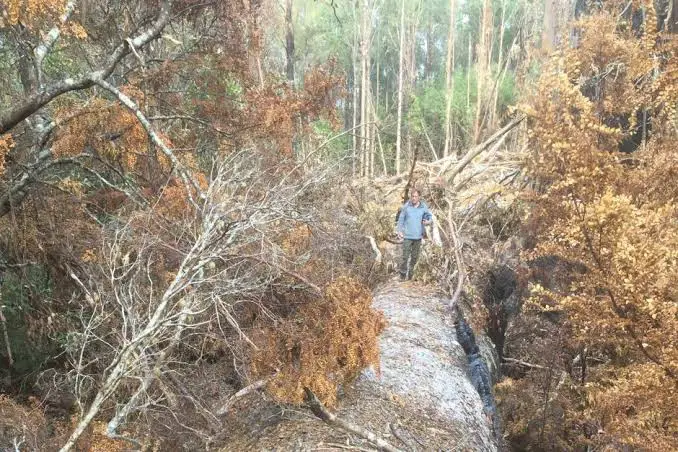
- 282 ft / 86 m
- Tasmania, Australia
Eucalyptus obliqua, commonly referred to as the Messmate Stringybark or King Stringy, is a tall, long-lived eucalypt species native to south-eastern Australia. This iconic tree is notable for its impressive height, fibrous stringy bark, and its importance in Australian botanical history.
Under optimal environmental conditions, Eucalyptus obliqua can grow up to 90 meters (295 feet) tall, with trunk diameters reaching as much as 3 meters (10 feet). The rough, stringy bark—characteristic of the species—covers both the main trunk and larger primary branches, while the finer upper branches are typically clad in smoother, greyish bark.
The foliage of Messmate Stringybark features glossy green, lanceolate to curved leaves that are commonly asymmetrical at the base—an attribute reflected in the species’ Latin name, obliqua, meaning “oblique.”
Specimens colloquially known as “King Stringy” represent some of the oldest living Eucalyptus obliqua individuals, potentially several centuries old. While exact ages vary, these trees’ lifespans can be studied using methods such as dendrochronology or documented through historical and ecological records.
9. Alpine Ash
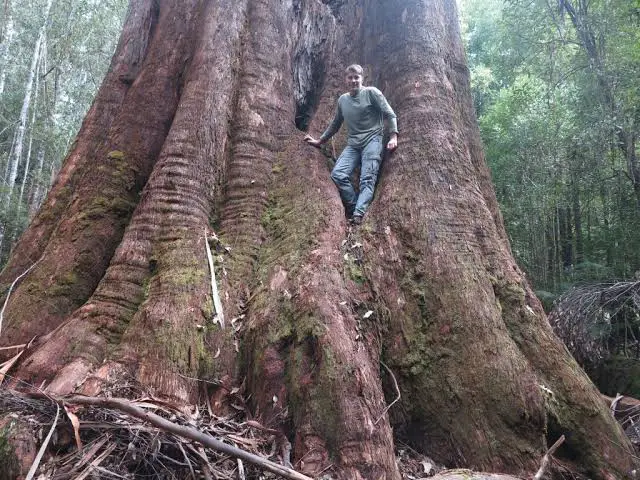
- 288 ft / 88 m
- Florentine Valley, Tasmania, Australia
Eucalyptus delegatensis, commonly known as Alpine Ash, is a tall, evergreen eucalypt species native to high-altitude regions of southeastern Australia, particularly within the states of Victoria, New South Wales, and Tasmania. This species is ecologically significant in cool, mountainous environments, where it often dominates the landscape.
Mature specimens of Alpine Ash typically attain heights of 40 to 60 meters (approximately 130 to 197 feet), with exceptional individuals reaching up to 90 meters (300 feet). These trees are characterized by a straight, upright trunk with thick, fibrous bark at the base, transitioning to smooth, pale to white bark on the upper trunk and branches.
The foliage consists of lance-shaped, glossy green leaves that may grow up to 15 centimeters in length. From late spring to early summer, Eucalyptus delegatensis produces clusters of white flowers, which serve as a food source for a variety of native pollinators.
This species commonly forms extensive forests at elevations between 900 and 1,500 meters, and is notable for its ability to establish pure stands in moist, cool-climate mountain regions. These large forest reserves play a vital role in alpine and subalpine ecosystems of southeastern Australia.
8. Neeminah Loggerale Meena
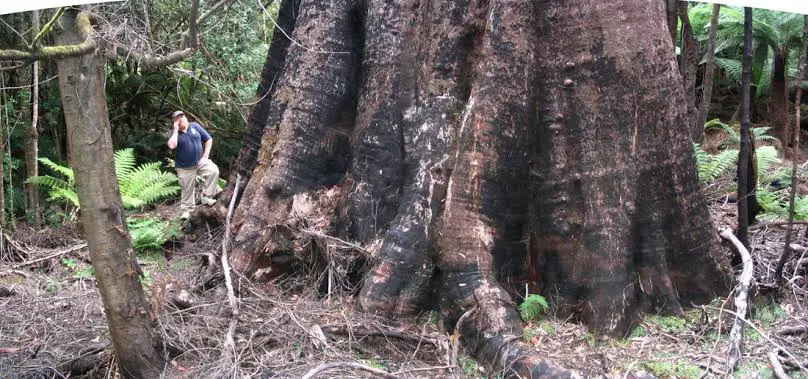
Eucalyptus globulus, commonly known as the Southern Blue Gum, is a fast-growing, tall evergreen tree native to southeastern Australia. Renowned for its impressive height, this iconic eucalypt species typically reaches between 45 to 70 meters (150–230 feet), making it one of the tallest hardwoods in its native range.
The Southern Blue Gum is easily identified by its smooth, pale bark, which peels away in long strips to reveal fresh white or cream-colored layers beneath. The base of the trunk often retains rough, ragged bark, adding to its distinctive dangerous tree appearance.
From late winter through early summer, Eucalyptus globulus produces clusters of white flowers, which are followed by woody, conical fruits. These flowers serve as an important resource for pollinators, including native insects and birds.
This species exhibits rapid vertical growth, often achieving the majority of its height within the first 10 years. When affected by fire or physical damage, it demonstrates strong resilience by resprouting from a lignotuber—a woody swelling at the tree’s base that stores energy and regenerative tissue.
Eucalyptus globulus is highly valued for its dense, durable timber, which ranges in color from pale straw to pinkish-brown. Its wood is widely used in the construction industry and is a key resource in paper pulp production, making it an economically significant species both in Australia and in global forestry operations.
7. White Knights
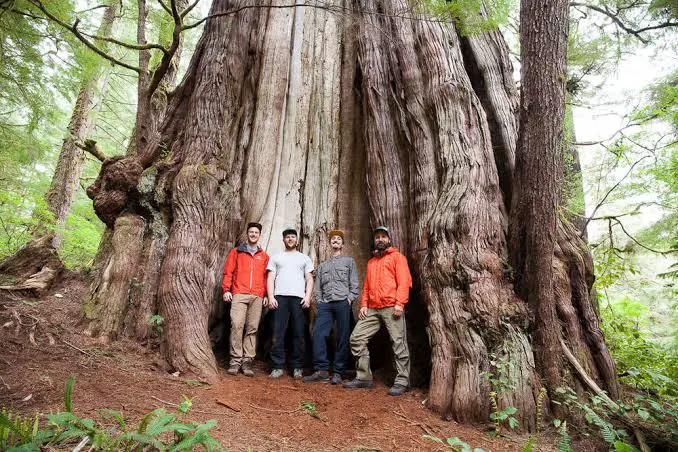
Eucalyptus viminalis, commonly known as Manna Gum or Ribbon Gum, is a tall, elegant native Australian tree recognized for its striking white bark, ecological significance, and association with some of the tallest hardwoods in the world. A typical Manna Gum can reach heights of up to 40 meters, while exceptional specimens—particularly those in northeastern Tasmania—such as the renowned “White Knights”, have been recorded at over 90 meters, placing them among the tallest known broadleaf trees globally.
The tree’s trunk is typically straight and clad in smooth, powdery white bark, which peels off in long ribbons—a distinctive trait that contributes to its alternate name, Ribbon Gum. Near the tree’s base, rougher bark often remains, creating a visual contrast between upper and lower sections of the trunk.
Eucalyptus viminalis features lance-shaped, glossy green leaves, which serve as a primary food source for koalas (Phascolarctos cinereus), as well as other arboreal marsupials such as sugar gliders (Petaurus breviceps) and yellow-bellied gliders (Petaurus australis). During the summer and autumn months, the tree produces clusters of small white flowers, typically grouped in threes, providing rich nectar resources for a variety of insect pollinators and nectar-feeding birds.
A notable ecological and cultural feature of the Manna Gum is its production of manna—a sweet, sugary sap exuded from wounds in the bark. This natural substance is eagerly consumed by wildlife and was historically harvested by Indigenous Australians for its nutritional and medicinal value.
6. Menara / Borneo Yellow Meranti
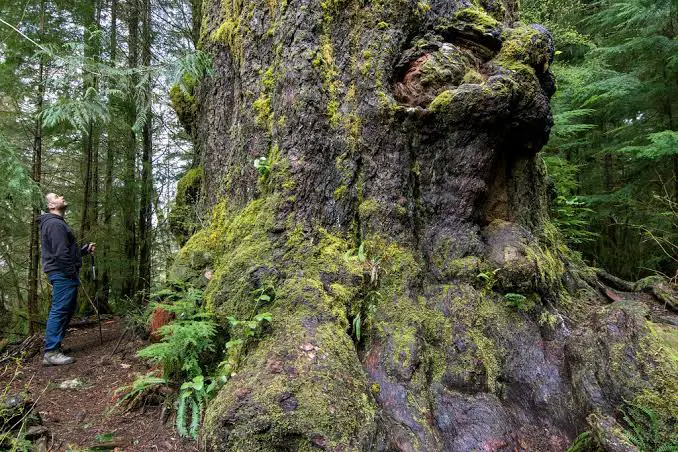
The Menara tree, scientifically identified as Shorea faguetiana and commonly known as the Borneo Yellow Meranti, is an exceptional tropical hardwood species located in the Danum Valley Conservation Area of Sabah, Malaysia. This individual tree holds the official record as the tallest known tropical tree and is also among the tallest flowering plants on Earth, reaching a verified height of 100.8 meters (331 feet)—measured from the lowest point of its buttressed base.
The Menara tree features a massive crown spread of approximately 40 meters, and its towering trunk, which contributes over 95% of its total biomass, accounts for the majority of its estimated 81.5 tonnes in weight.
This beautiful tree’s structural dominance illustrates the tree’s symmetrical architecture, vertical stability, and biomechanical efficiency, even though it grows on a sloped terrain.
Shorea faguetiana belongs to the Dipterocarpaceae family, a key group of tropical hardwoods that dominate the lowland rainforests of Southeast Asia. Menara displays classic dipterocarp features, including smooth gray bark, a lush green canopy, and remarkable vertical growth—attributes enhanced by the relatively calm climatic conditions of Sabah, often referred to as “the land beneath the wind”, due to the rarity of strong storms.
The Menara tree was discovered using airborne LiDAR technology, with its dimensions verified through 3D modeling and manual climbing measurements via tape drop methods. This combination of advanced geospatial scanning and traditional fieldwork provided one of the most accurate assessments of a tropical tree’s structure ever recorded.
As a symbol of tropical rainforest conservation, Menara has become an icon of environmental preservation efforts in Malaysia and beyond. Its global significance was further recognized when it was featured on a Malaysian postage stamp, underscoring its national importance. However, like many tropical giants, the Menara tree faces increasing threats from deforestation, emphasizing the urgent need to protect the fragile ecosystems of Borneo’s rainforests.
5. Unnamed Giant Sequoia
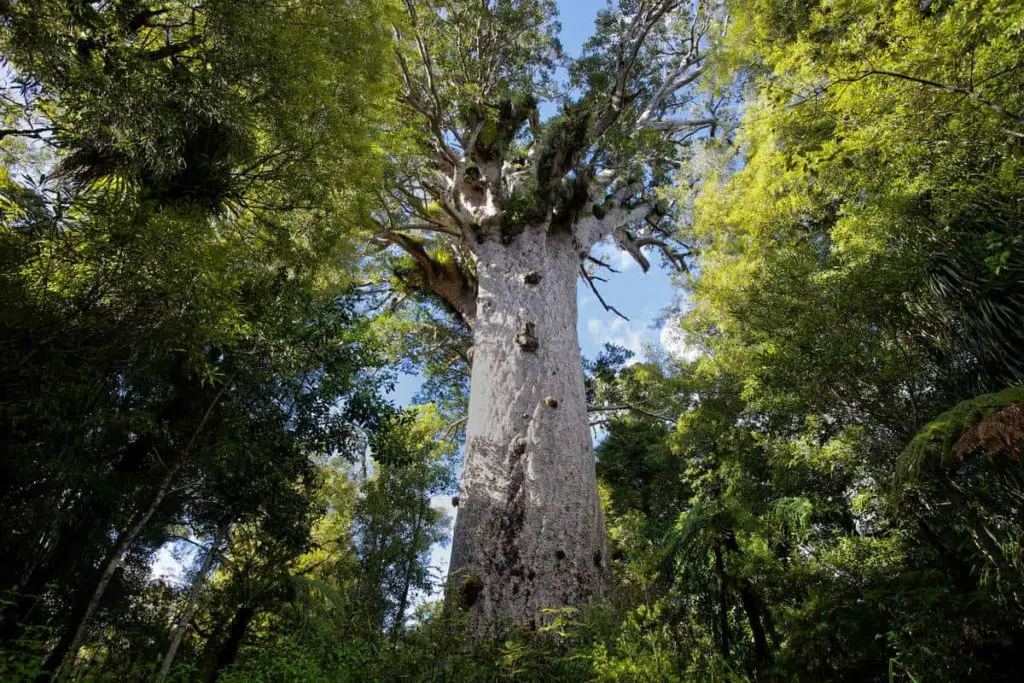
The Unnamed Giant Sequoia, a monumental specimen of Sequoiadendron giganteum, ranks among the largest living trees on Earth by wood volume. While not the tallest, Giant Sequoias are globally renowned for their immense mass, making them the most massive tree species in terms of total trunk volume. Though the General Sherman Tree holds the record as the largest known living sequoia, this unnamed giant is comparably impressive, with an estimated trunk volume exceeding 1,400 cubic meters (approximately 50,000 cubic feet).
Typical Giant Sequoias can grow beyond 80 meters (260 feet) in height and develop trunk diameters surpassing 7 meters (23 feet) at the base—wider than many urban streets. These dimensions contribute to their status as true natural megaflora.
Sequoiadendron giganteum is endemic to the Sierra Nevada Mountains of California, United States, where it grows in high-elevation groves under specific ecological conditions. These include deep winter snowpack, well-drained, nutrient-rich soils, and frequent low-intensity wildfires. The species has evolved a unique fire-adapted strategy: its thick, fire-resistant bark protects the tree during burns, while fire plays a vital role in reproduction by opening serotinous cones and preparing the soil for seed germination.
Giant Sequoias are also known for their exceptional longevity, with many individuals living over 2,000 years, and some believed to be more than 3,000 years old. Despite their age and size, they continue to add significant biomass annually, demonstrating one of the fastest mass-growth rates among trees of their size class—accumulating substantial wood volume each year.
4. Raven’s Tower (Sitka Spruce – Picea sitchensis)
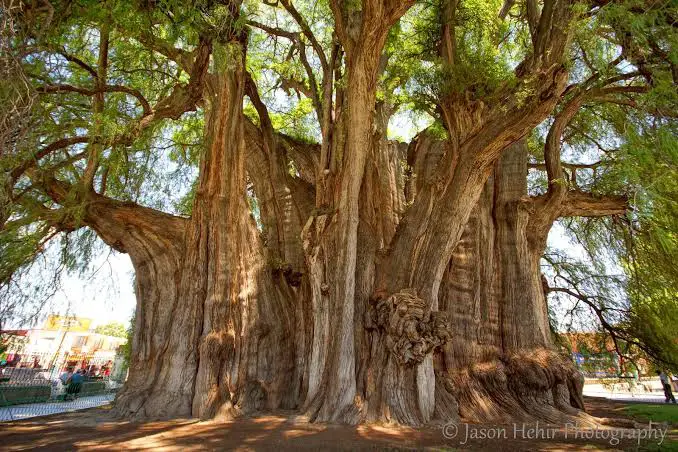
Raven’s Tower is an exceptional specimen of the Sitka Spruce (Picea sitchensis), recognized as the tallest known individual of its species. Reaching an extraordinary height of approximately 317 feet (97 meters), this towering tree stands within Prairie Creek Redwoods State Park in Northern California, a region known for its ancient forests and towering conifers.
Although its size rivals some of the most iconic trees in North America, Raven’s Tower remains relatively unknown to the public compared to its more famous redwood neighbors. To protect this natural giant from potential damage caused by human traffic, the tree’s precise location has been intentionally kept secret by conservationists and park officials.
The Sitka Spruce is a coniferous evergreen tree native to the Pacific Northwest, and Raven’s Tower exemplifies the maximum growth potential of the species under ideal conditions. Its massive, straight trunk and exceptional height are the result of the cool, moist coastal climate provided by the protected forest ecosystem of Prairie Creek Redwoods State Park, which was established in the 1920s as part of California’s broader efforts to preserve old-growth forests.
While Sitka Spruce wood is highly valued in the global timber industry—particularly in applications like aircraft construction, musical instruments, and boat building—Raven’s Tower has been preserved as a natural monument, offering a living example of what this species can achieve when allowed to grow undisturbed in its native habitat.
3. Doerner Fir (Coast Douglas-fir – Pseudotsuga menziesii)
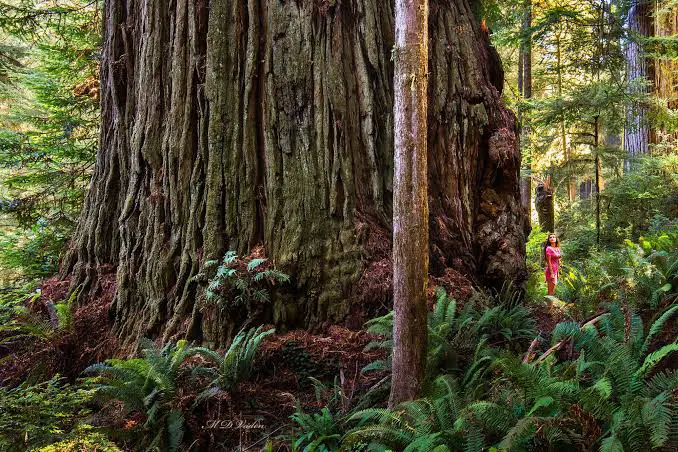
The Doerner Fir, also known as the Brummitt Fir, is an extraordinary Coast Douglas-fir (Pseudotsuga menziesii var. menziesii) and ranks among the tallest non-redwood trees ever recorded. Located in Coos County, in the state of Oregon, this iconic conifer reached a measured height of approximately 327 feet (99.7 meters) in 2011, with a circumference of 36 feet (11 meters)—placing it among the tallest Douglas-firs ever documented.
At its peak, when measured from the lowest point of the sloped ground to the very top of the crown, the tree’s total height was estimated at around 339 feet (103 meters). Despite a partial crown loss due to a wildfire in August 2025, the Doerner Fir continues to stand as a towering symbol of resilience in the Pacific Northwest’s coniferous forests.
Estimated to be around 450 years old, this tree exemplifies the longevity and structural durability characteristic of mature Douglas-fir trees. The Doerner Fir grows within a publicly managed forest overseen by the U.S. Bureau of Land Management (BLM). While much of the surrounding forest has undergone extensive logging, this monumental tree survives as a rare remnant of old-growth Douglas-fir forest, highlighting its ecological and historical significance.
2. Centurion (Mountain Ash – Eucalyptus regnans)
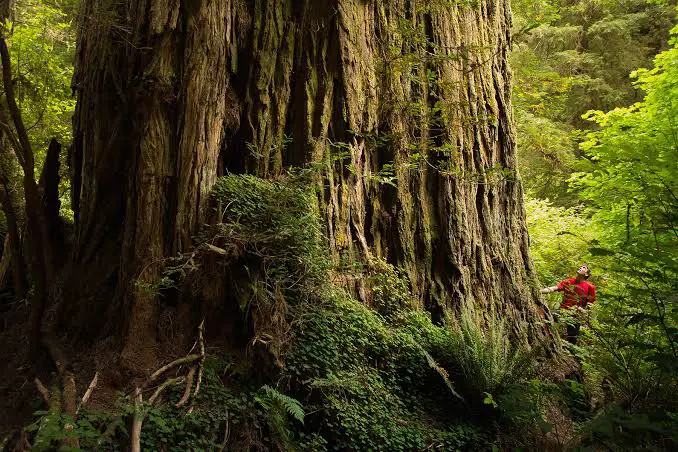
Centurion is an exceptional specimen of the Mountain Ash (Eucalyptus regnans), and holds the title of the tallest known living hardwood tree and tallest flowering plant on Earth. Located in southern Tasmania, Australia, this monumental tree represents the upper limits of vertical growth in angiosperms.
Discovered in 2008 through LiDAR aerial mapping technology, Centurion was initially measured at a height of 99.6 meters (327 feet). A more precise measurement using ground-based laser scanning in 2018 estimated its maximum height at approximately 100.5 meters (330 feet). Although the tree sustained damage during the 2019 Tasmanian bushfires, it still stands at a towering 96 meters, placing it among the tallest trees in the world.
Centurion boasts a trunk diameter of approximately 4.05 meters, a girth exceeding 12 meters, and an estimated wood volume of 268 cubic meters—making it not only tall but also impressively massive. The tree grows in a remnant patch of ancient forest surrounded by secondary regrowth, having narrowly escaped threats from wildfires, logging operations, and high winds over time.
The name “Centurion” was given to mark two milestones: its proximity to 100 meters in height, and the fact that it was the 100th “noble tree” identified by Forestry Tasmania, the state authority responsible for forest management and conservation.
1. General Sherman
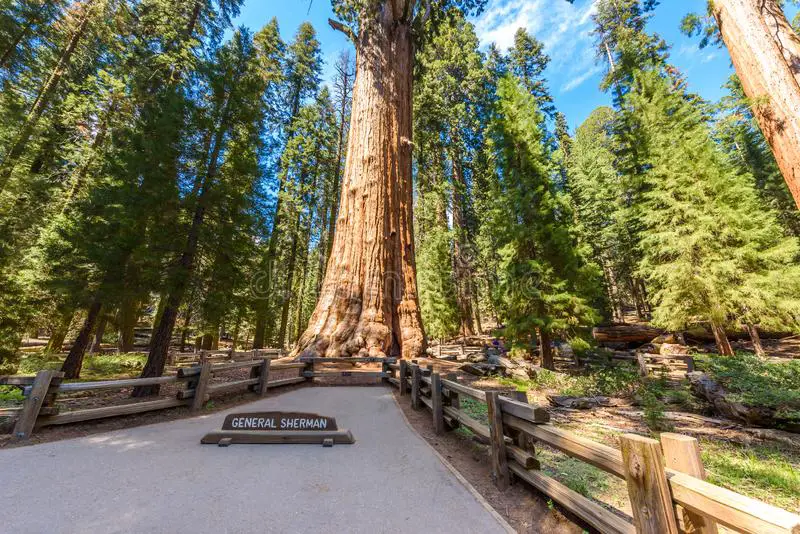
Hyperion (Sequoia sempervirens): The Tallest Living Tree on Earth
Hyperion is an extraordinary specimen of the Coast Redwood (Sequoia sempervirens) and holds the record as the tallest known living tree on Earth. Located within Redwood National Park in northern California, this natural giant was discovered in 2006 by naturalists Chris Atkins and Michael Taylor. At the time of discovery, Hyperion measured 115.55 meters (379.1 feet) tall. By 2019, it had grown to an even more impressive 116.07 meters (380.8 feet)—a height that exceeds the Statue of Liberty, cementing its status as a global botanical marvel.
The tree’s trunk diameter measures approximately 4.94 meters (16 feet), and it contains an estimated 530 cubic meters (18,600 cubic feet) of wood volume. Hyperion also has the deepest crown ever recorded for a redwood, stretching nearly 91 meters (298 feet) from the top to the lowest foliage. Its age is estimated between 600 and 800 years, and it thrives in the cool, foggy coastal climate of California’s north coast, where persistent moisture plays a crucial role in supporting redwood growth and longevity.
The General Sherman Tree (Sequoiadendron giganteum): The Largest Tree by Volume
While Hyperion holds the record for height, the Giant Sequoia (Sequoiadendron giganteum) is recognized as the largest tree species by volume. The most famous of these giants, the General Sherman Tree, is located in Sequoia National Park, also in California. This iconic tree stands at about 83.8 meters (275 feet) tall, but its massive trunk volume, estimated at 1,487 cubic meters (52,508 cubic feet), makes it the largest known single-stem tree on Earth.
The General Sherman Tree is estimated to be between 2,300 and 2,700 years old, ranking it among the oldest living trees on the planet. Giant Sequoias are known for their enormous trunk diameters, often exceeding 7 meters (23 feet), and for their remarkable fire resistance, made possible by their thick, insulating bark. These trees can regenerate after wildfires and survive for millennia, contributing to their reputation as symbols of endurance, resilience, and ecological grandeur.
Although Giant Sequoias are not the tallest trees—a title held by the Coast Redwoods—they surpass all other species in bulk and biomass. Found primarily in the old-growth forests of the Sierra Nevada Mountains, they represent some of the largest and most ancient organisms on Earth. Ongoing preservation efforts aim to protect these living giants from threats such as climate change, wildfire, drought, and human impact, ensuring their survival for future generations.
These Top 10 Biggest Trees in the World showcase awe-inspiring beauty and power of nature.
From the towering sequoias of California to the ancient kauri trees of New Zealand, each tree on this list is a testament to the grandeur and resilience of our natural world.
These majestic giants, with their towering presence and widest trunks, are actually much bigger than they look and help maintain local ecosystem.
They are a reminder of our past, and they offer hope for our future. We must do everything we can to protect these giants, so that they can continue to stand for centuries to come.
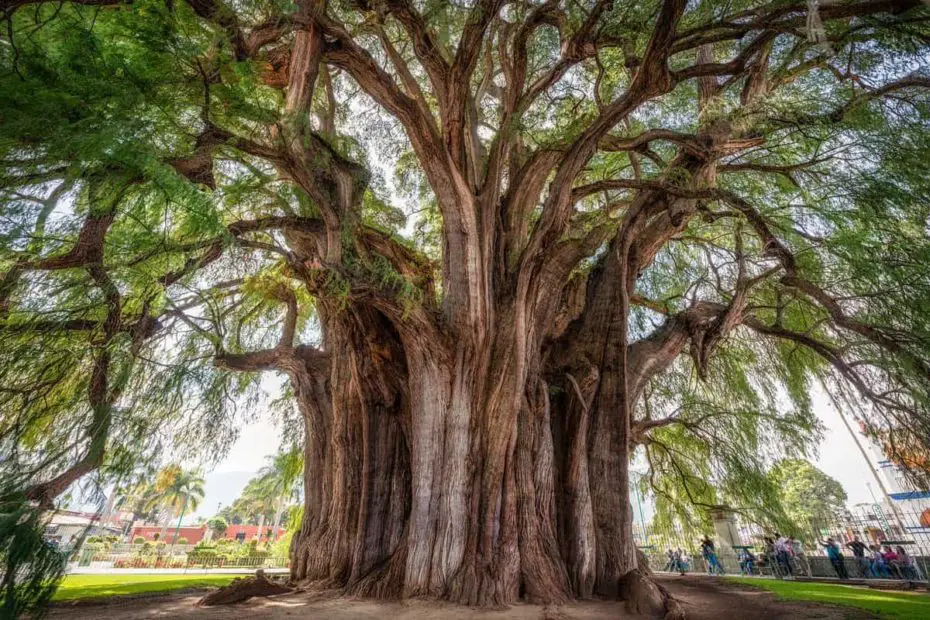
Inappropriate human things and overfarming is causing these trees and forests more harm.
These are twigs in comparison to the trees that were cut down worldwide. These are beautiful and may be the last of those that weren’t destroyed so I’m not bashing I just wish more journalists would start bringing this information to light🕯️
Please watch Terry R Eicher YouTube Channel called Flat Out Truth.
Yes, he is a flat earther, but so was all of us long before the big LIE. GOD did not create a Globe.